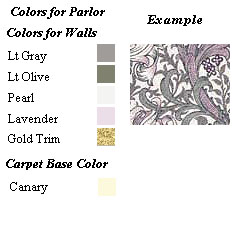“The Parlor”
The furnishing of the parlor should be subject to its architectural finish. The first things to be considered are the walls and floor. The former may be decorated in fresco or papered, according to the individual taste and means. The prettiest styles of parlor paper are light tints of gray, olive, pearl, and lavender grounds, and in small scroll patterns, panels, birds, and vines, finished in heavy gold traceries, with dado and frieze to correspond.
The styles of carpet mostly used are Brussels, Wilton, tapestry, and Axminister. A tapestry carpet in light canary ground, with clusters of lotus, or begonia leaves, makes a charming background to almost all the colors generally used in upholstery.
In selecting the furniture, the first thought should be given to its true worth. Chairs and couches should be chosen for comfort rather than style. They should be of solid make, easy, graceful, and of good, serviceable colors and materials. The most serviceable woods to select in frames are ebony, oak, walnut, cherry, and mahogany. These frames are finished in different styles-plain, carved, inlaid, and gilt-and are upholstered in all shades of satin, plush, rep, silk, and damask. These come at prices within the means of a slender purse. That slippery abomination in the shape of haircloth furniture should be avoided. The latest design in parlor furniture is in the Turkish style, the upholstery being made to cover the frame. Rich Oriental colors in woolen and silk brocades are mostly used, and the trimmings are cord and tassels or heavy fringe.
Formerly the parlor appointments were all in sets or pairs, but this fashion is no longer observed, as the most tastefully arranged parlor has now no two pieces of furniture alike; but two easy-chairs placed opposite each other are never out of place. Here may stand an embroidered ottoman, there a quaint little chair, a divan can take some central position; a cottage piano, covered with some embroidered drapery, may stand at one end of the room, while an ebony or mahogany cabinet, with its panel mirrors and quaint brasses, may be placed at the other end, its racks and shelved affording an elegant display for pretty pieces of bri-a-brac.
Marble-topped center-tables are no longer in use. Tables in inlaid woods, or hand-painted, are used for placing books or albums on. A small, airy-looking table elaborately
mounted in gilt, may stand near a window or wall. The mantel mirror, with its beveled edges and racks arranged on each side, looks very effective when decorated with pretty oddities-ferns, grasses, and pieces of old china. A jardiniere filled with living plants and placed near a bay window makes an elegant ornament. Care should be taken in arranging that the room be not overcrowded. There should be a few good pictures or painted plaques mounted in plush hung on the walls; a portrait may be placed on a common easel and draped with a scarf in old gold or peacock-blue and tiny lambrequins, painted or embroidered, may hang beneath a bracket supporting a bust or flower-vase.
An embroidered scarf with fringed ends may be placed on the back of a chair or sofa in place of the old lace tidy. A sack made of small pieces of bright-colored plush or silk in crazy work may be flung across the table, the ends dropping very low. The mantelpiece may be covered with a corresponding sash, over which place a small clock as centerpiece and arrange ornaments on each side – statuettes, bennerets, flower-holders, small Japanese fans, pieces of odd china, painted candles in small scenes, may all find a place on the mantel.
Window curtains of heavy fabric, hung from brass or plush mounted poles, may be gracefully draped to the sides while the inner lace ones should be hung straight and be fastened in the center with some ornament or bow of ribbon corresponding in shade to the general tone of the room. The straight shades next to the glass may correspond in tone to the outside walls or window-facings; but this is a mere matter of taste. White or light-tinted shades, finished in etching or narrow lace, are always in vogue.
The dado shades are the latest innovation in window decoration. These come in all colors from the lightest to the darkest shades, with dado in tile. arabesque and fresco and patterns, finished in lace, fringe, and brasses.
Portieres (curtain doors) have superseded folding doors. These should be in shaded to contrast the general blending of the colors in the room. The fabrics mostly used are India goods, but they may be of any material, from expensive tapestries, satins, and plushes, to the ten-cent factory cottons. The curtains, if made from striped tapestry and Turcoman, will give the finishing artistic touches to almost any room, but the last softening polish comes only from the genial presence of trailing and climbing vines.
2006-02-07

